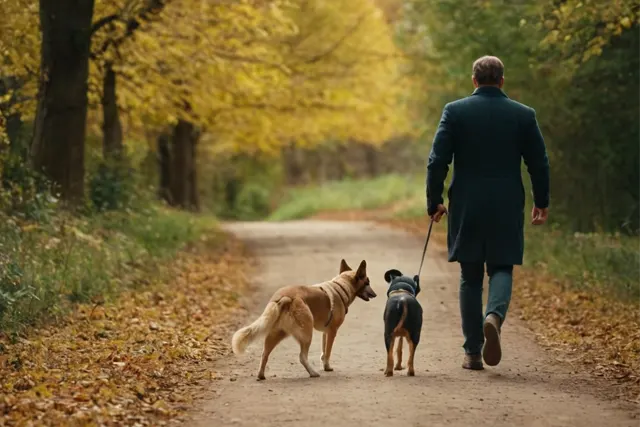Walk the Dog Before or After Eating? - Expert Advice and Tips


Benefits of Walking the Dog Before Eating
Many dog owners wonder whether it is better to walk their furry friends before or after mealtime. While there is no one-size-fits-all answer to this question, there are several benefits to consider when it comes to walking your dog before eating.
1. Energy Burn: Taking your dog for a walk before eating can help burn off excess energy. Dogs are naturally active animals, and a walk can provide them with the physical exercise they need to stay healthy and happy. By expending some energy before mealtime, your dog may be more relaxed and less likely to exhibit hyperactive behavior.
2. Improved Digestion: Walking your dog before eating can also help stimulate their digestive system. The physical activity can aid in the movement of food through their digestive tract, promoting better digestion and nutrient absorption. This can be particularly beneficial for dogs that are prone to digestive issues or have sensitive stomachs.
3. Training Opportunities: Walking your dog before eating can provide an excellent opportunity for training. Dogs are often more receptive to learning and following commands when they have had a chance to burn off some energy. By incorporating training exercises into your pre-meal walk, you can reinforce good behavior and obedience in your dog.
Benefits of Walking the Dog After Eating
While walking your dog before eating has its advantages, there are also benefits to taking your furry friend for a stroll after mealtime.
1. Digestive Aid: Walking your dog after eating can help facilitate the digestion process. The physical activity can stimulate the muscles in their digestive tract, promoting the movement of food and preventing any potential discomfort or bloating. This can be particularly beneficial for dogs that are prone to gastrointestinal issues.
2. Bonding Time: Walking your dog after eating can provide an excellent opportunity for bonding. Taking a leisurely stroll together can strengthen the bond between you and your furry friend. It allows for quality time spent together, away from distractions, and can be a calming and enjoyable experience for both of you.
3. Preventing Boredom: Walking your dog after eating can help prevent boredom. Dogs are intelligent animals that thrive on mental and physical stimulation. A post-meal walk can provide them with the opportunity to explore their surroundings, sniff new scents, and engage their senses. This can help prevent destructive behavior that may arise from boredom.
Considerations for Walking the Dog Before Eating
While walking your dog before eating can have its benefits, there are a few considerations to keep in mind.
1. Hunger Levels: If you choose to walk your dog before eating, ensure that they are not overly hungry. A hungry dog may become distracted during the walk, making it difficult to maintain their focus and obedience. Consider giving them a small snack before the walk to keep their hunger levels in check.
2. Time Constraints: Walking your dog before eating may require additional time in your daily routine. If you have a busy schedule, it is essential to allocate enough time for both the walk and mealtime. Rushing through the walk or feeding your dog too quickly can lead to digestive issues or behavioral problems.
3. Weather Conditions: Be mindful of the weather conditions when deciding to walk your dog before eating. Extreme heat or cold can be uncomfortable and potentially harmful to your dog's health. If the weather is unfavorable, consider adjusting your walking schedule accordingly.
Considerations for Walking the Dog After Eating
Walking your dog after eating also requires some considerations to ensure their well-being.
1. Digestive Rest: Allow your dog some time to rest and digest their food before going for a walk. Walking immediately after eating can potentially lead to digestive discomfort or even gastric torsion, a severe condition that requires immediate veterinary attention. Aim to wait at least 30 minutes to an hour after your dog has finished eating before going for a walk.
2. Leash Walking: If you choose to walk your dog after eating, it is crucial to keep them on a leash. The post-meal walk may stimulate their senses and instincts, making them more prone to chasing after squirrels, birds, or other distractions. Keeping them on a leash ensures their safety and prevents any potential accidents or injuries.
3. Moderate Exercise: When walking your dog after eating, opt for a moderate-paced walk rather than intense exercise. Vigorous activity immediately after a meal can interfere with the digestion process and potentially lead to discomfort or bloating. Keep the walk calm and relaxed to allow for proper digestion.
Expert Recommendations
While there are benefits to both walking your dog before or after eating, it ultimately depends on your dog's individual needs and preferences. Consulting with a veterinarian or professional dog trainer can provide valuable insights and recommendations tailored to your specific dog.
Experts generally suggest waiting at least 30 minutes to an hour after your dog has finished eating before going for a walk. This allows for proper digestion and reduces the risk of any potential health issues. However, if your dog has specific dietary or health concerns, it is best to consult with a professional to determine the most suitable walking routine.
Conclusion
Deciding whether to walk your dog before or after eating is a personal choice that should take into consideration your dog's individual needs and preferences. Both options have their benefits, and it is essential to weigh the pros and cons before making a decision.
Ultimately, the most important thing is to ensure that your dog gets regular exercise and maintains a healthy lifestyle. Whether you choose to walk your dog before or after eating, make sure to provide them with a balanced diet, plenty of fresh water, and regular opportunities for physical activity.
Remember to always monitor your dog's behavior and consult with a professional if you have any concerns or questions regarding their walking routine or overall health.


Related posts